HI6026 Audit Assignment 1: Enhanced Auditor Reporting in Australia
VerifiedAdded on 2023/06/04
|15
|2916
|471
Report
AI Summary
This report analyzes the significance of enhanced audit reporting, focusing on the introduction of "Key Audit Matters" (KAMs) in the audit function. The assignment evaluates the financial report of Telstra Group, an ASX-listed company, to understand how the revised auditing standards, approved by the AUASB, are applied. It covers auditor independence, non-audit services, and a detailed analysis of auditor remuneration. The report delves into key audit matters such as impairment of goodwill and intangible assets, capitalization and asset lives, revenue recognition, revenue from contracts with customers, and reliance on automated processes. The audit procedures performed by the auditor and the role of the Audit Committee are also discussed. The report concludes with the auditor's opinion, directors' responsibilities, material subsequent events, and follow-up questions for the Annual General Meeting. The report highlights the importance of transparency and insight in audit reporting, meeting the assignment's objective by demonstrating the application of auditing standards and the disclosure of relevant matters in the audit report.
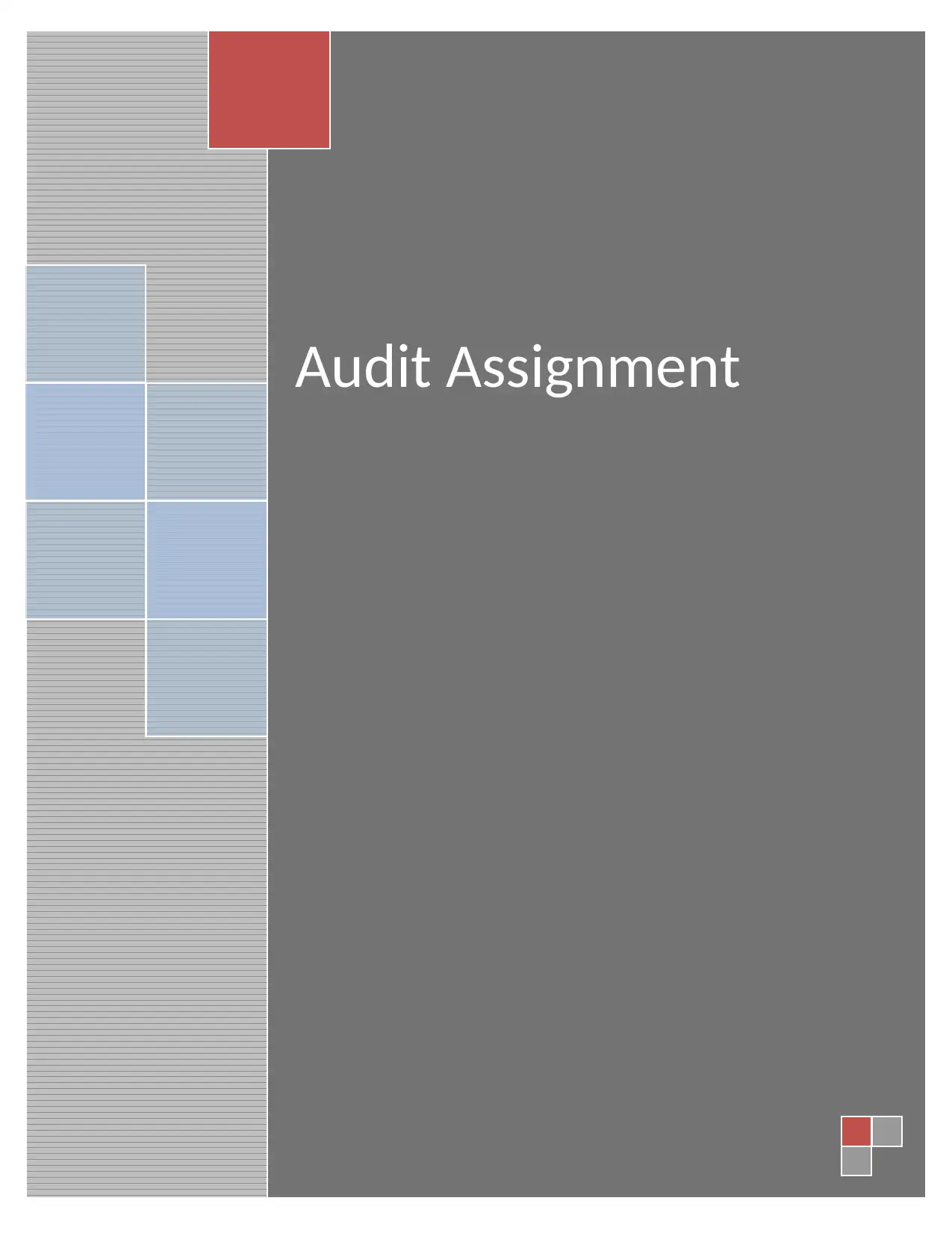
Audit Assignment
Paraphrase This Document
Need a fresh take? Get an instant paraphrase of this document with our AI Paraphraser

1
By student name
Professor
University
Date: 16th Sep 2018.
1 | P a g e
By student name
Professor
University
Date: 16th Sep 2018.
1 | P a g e

2
Executive Summary
The objective of this assignment is to accentuate the significance of enhanced audit reporting in
the audit function. For the clear understanding of this topic a bunch of selected questions has
been answered with help of the annual report of an ASX listed company, we have considered
Telstra Group in our case. We have evaluated the financial report of the Group and reached to
the conclusion that the basic purpose of the assignment has been met. All the standards of
auditing have been applied by the auditor wherever applicable and all the matters which are to
the audit have been disclosed separately in the audit report.
2 | P a g e
Executive Summary
The objective of this assignment is to accentuate the significance of enhanced audit reporting in
the audit function. For the clear understanding of this topic a bunch of selected questions has
been answered with help of the annual report of an ASX listed company, we have considered
Telstra Group in our case. We have evaluated the financial report of the Group and reached to
the conclusion that the basic purpose of the assignment has been met. All the standards of
auditing have been applied by the auditor wherever applicable and all the matters which are to
the audit have been disclosed separately in the audit report.
2 | P a g e
⊘ This is a preview!⊘
Do you want full access?
Subscribe today to unlock all pages.

Trusted by 1+ million students worldwide

3
Contents
Introduction.................................................................................................................................................4
Analysis........................................................................................................................................................5
Conclusion...................................................................................................................................................7
References.................................................................................................................................................10
3 | P a g e
Contents
Introduction.................................................................................................................................................4
Analysis........................................................................................................................................................5
Conclusion...................................................................................................................................................7
References.................................................................................................................................................10
3 | P a g e
Paraphrase This Document
Need a fresh take? Get an instant paraphrase of this document with our AI Paraphraser
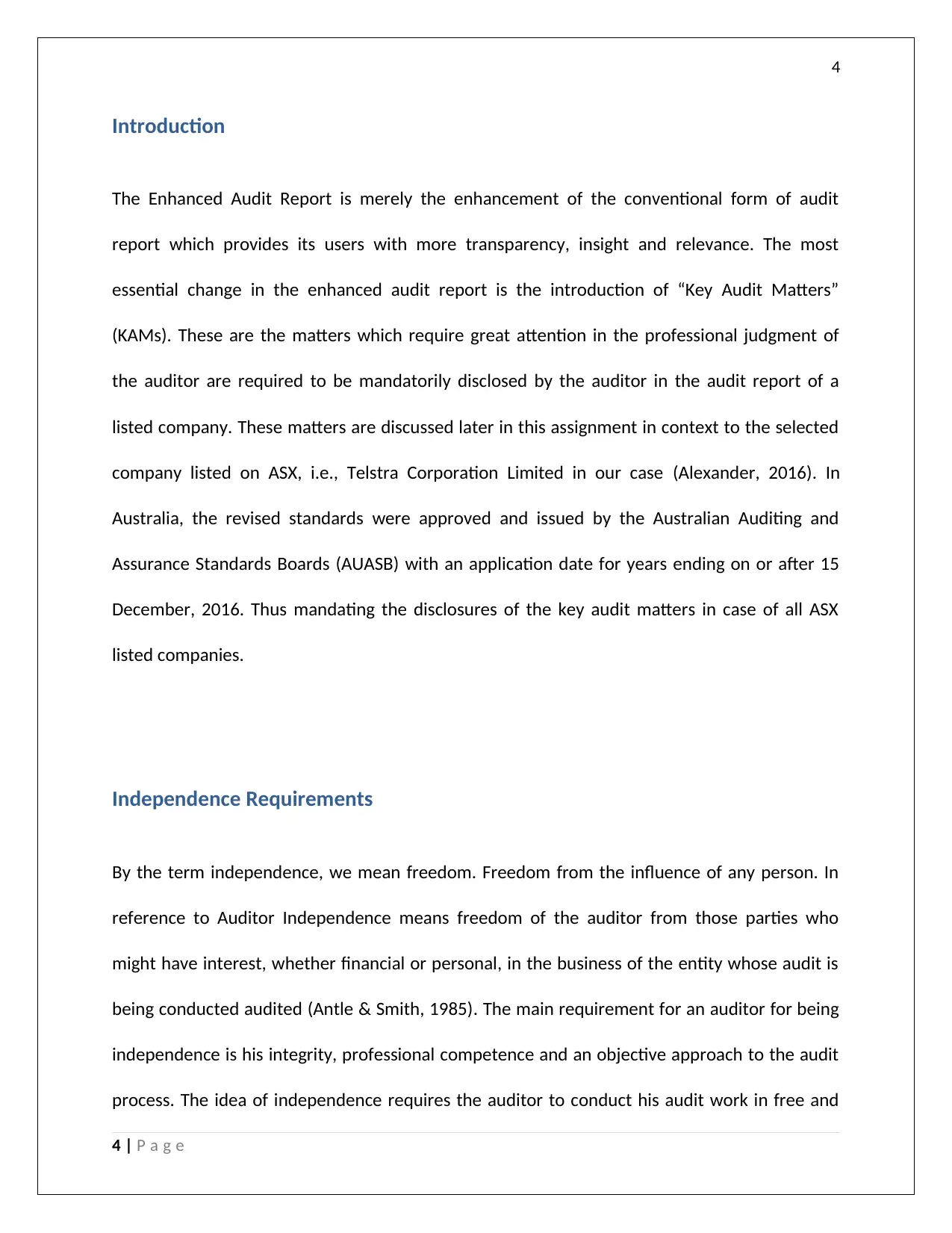
4
Introduction
The Enhanced Audit Report is merely the enhancement of the conventional form of audit
report which provides its users with more transparency, insight and relevance. The most
essential change in the enhanced audit report is the introduction of “Key Audit Matters”
(KAMs). These are the matters which require great attention in the professional judgment of
the auditor are required to be mandatorily disclosed by the auditor in the audit report of a
listed company. These matters are discussed later in this assignment in context to the selected
company listed on ASX, i.e., Telstra Corporation Limited in our case (Alexander, 2016). In
Australia, the revised standards were approved and issued by the Australian Auditing and
Assurance Standards Boards (AUASB) with an application date for years ending on or after 15
December, 2016. Thus mandating the disclosures of the key audit matters in case of all ASX
listed companies.
Independence Requirements
By the term independence, we mean freedom. Freedom from the influence of any person. In
reference to Auditor Independence means freedom of the auditor from those parties who
might have interest, whether financial or personal, in the business of the entity whose audit is
being conducted audited (Antle & Smith, 1985). The main requirement for an auditor for being
independence is his integrity, professional competence and an objective approach to the audit
process. The idea of independence requires the auditor to conduct his audit work in free and
4 | P a g e
Introduction
The Enhanced Audit Report is merely the enhancement of the conventional form of audit
report which provides its users with more transparency, insight and relevance. The most
essential change in the enhanced audit report is the introduction of “Key Audit Matters”
(KAMs). These are the matters which require great attention in the professional judgment of
the auditor are required to be mandatorily disclosed by the auditor in the audit report of a
listed company. These matters are discussed later in this assignment in context to the selected
company listed on ASX, i.e., Telstra Corporation Limited in our case (Alexander, 2016). In
Australia, the revised standards were approved and issued by the Australian Auditing and
Assurance Standards Boards (AUASB) with an application date for years ending on or after 15
December, 2016. Thus mandating the disclosures of the key audit matters in case of all ASX
listed companies.
Independence Requirements
By the term independence, we mean freedom. Freedom from the influence of any person. In
reference to Auditor Independence means freedom of the auditor from those parties who
might have interest, whether financial or personal, in the business of the entity whose audit is
being conducted audited (Antle & Smith, 1985). The main requirement for an auditor for being
independence is his integrity, professional competence and an objective approach to the audit
process. The idea of independence requires the auditor to conduct his audit work in free and
4 | P a g e

5
impartial manner, as there are people who depend on the auditor’s opinion for making
decisions on various matters. Any prejudiced opinion from the auditor on the financial
statements of a company may adversely affect the decision making process of many users.
Hence, auditor’s independence is very crucial (Arnott, Lizama, & Song, 2017).
The independence declaration has been given by the partners of Ernest & Young Global Limited
for the financial year ended 30 June, 2018, declaring that there have been no contraventions in
respect of auditor independence requirements as per section 307C of the Corporations Act
2001 and also there has been no violation of any professional conduct which is required to be
followed in relation to the audit process (Belton, 2017).
Non –audit services provided
During the reporting period, the auditors have, other than the audit services which are required
to be performed during the course of audit, provided some non- audit services to the Company.
The details of the nature of the service and the amounts paid or payable in respect of each such
service are clearly provided under the head ‘Auditors’. All these non audit services provided by
the auditor based on the advice and directions as provided by the Audit & Risk Committee to
the satisfaction of the directors (Coate & Mitschow, 2017). The directors have assured that all
the non audit services provided during the year by the company’s auditor, Ernest & Young
Global Limited, are in approval of the company’s external audit service policy and the same are
codicillary to the confirmation of the management and EY that the independence of the auditor
5 | P a g e
impartial manner, as there are people who depend on the auditor’s opinion for making
decisions on various matters. Any prejudiced opinion from the auditor on the financial
statements of a company may adversely affect the decision making process of many users.
Hence, auditor’s independence is very crucial (Arnott, Lizama, & Song, 2017).
The independence declaration has been given by the partners of Ernest & Young Global Limited
for the financial year ended 30 June, 2018, declaring that there have been no contraventions in
respect of auditor independence requirements as per section 307C of the Corporations Act
2001 and also there has been no violation of any professional conduct which is required to be
followed in relation to the audit process (Belton, 2017).
Non –audit services provided
During the reporting period, the auditors have, other than the audit services which are required
to be performed during the course of audit, provided some non- audit services to the Company.
The details of the nature of the service and the amounts paid or payable in respect of each such
service are clearly provided under the head ‘Auditors’. All these non audit services provided by
the auditor based on the advice and directions as provided by the Audit & Risk Committee to
the satisfaction of the directors (Coate & Mitschow, 2017). The directors have assured that all
the non audit services provided during the year by the company’s auditor, Ernest & Young
Global Limited, are in approval of the company’s external audit service policy and the same are
codicillary to the confirmation of the management and EY that the independence of the auditor
5 | P a g e
⊘ This is a preview!⊘
Do you want full access?
Subscribe today to unlock all pages.

Trusted by 1+ million students worldwide
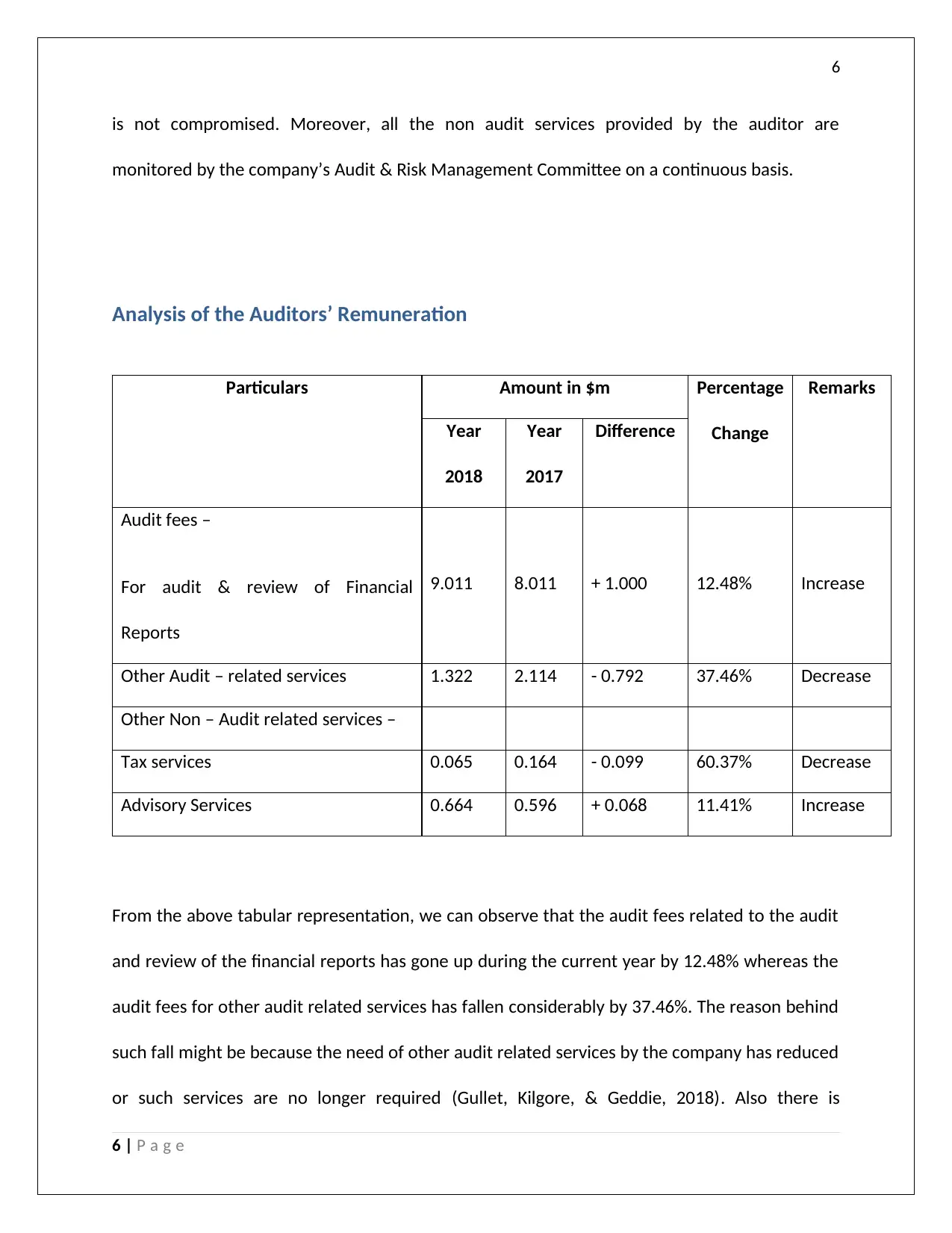
6
is not compromised. Moreover, all the non audit services provided by the auditor are
monitored by the company’s Audit & Risk Management Committee on a continuous basis.
Analysis of the Auditors’ Remuneration
Particulars Amount in $m Percentage
Change
Remarks
Year
2018
Year
2017
Difference
Audit fees –
For audit & review of Financial
Reports
9.011 8.011 + 1.000 12.48% Increase
Other Audit – related services 1.322 2.114 - 0.792 37.46% Decrease
Other Non – Audit related services –
Tax services 0.065 0.164 - 0.099 60.37% Decrease
Advisory Services 0.664 0.596 + 0.068 11.41% Increase
From the above tabular representation, we can observe that the audit fees related to the audit
and review of the financial reports has gone up during the current year by 12.48% whereas the
audit fees for other audit related services has fallen considerably by 37.46%. The reason behind
such fall might be because the need of other audit related services by the company has reduced
or such services are no longer required (Gullet, Kilgore, & Geddie, 2018). Also there is
6 | P a g e
is not compromised. Moreover, all the non audit services provided by the auditor are
monitored by the company’s Audit & Risk Management Committee on a continuous basis.
Analysis of the Auditors’ Remuneration
Particulars Amount in $m Percentage
Change
Remarks
Year
2018
Year
2017
Difference
Audit fees –
For audit & review of Financial
Reports
9.011 8.011 + 1.000 12.48% Increase
Other Audit – related services 1.322 2.114 - 0.792 37.46% Decrease
Other Non – Audit related services –
Tax services 0.065 0.164 - 0.099 60.37% Decrease
Advisory Services 0.664 0.596 + 0.068 11.41% Increase
From the above tabular representation, we can observe that the audit fees related to the audit
and review of the financial reports has gone up during the current year by 12.48% whereas the
audit fees for other audit related services has fallen considerably by 37.46%. The reason behind
such fall might be because the need of other audit related services by the company has reduced
or such services are no longer required (Gullet, Kilgore, & Geddie, 2018). Also there is
6 | P a g e
Paraphrase This Document
Need a fresh take? Get an instant paraphrase of this document with our AI Paraphraser

7
considerable fall in the fees for tax compliance services by 60.37%, this could be because of
continuously developing technologies and the company might have adopted the latest
advanced technologies. An increase in the fees paid for advisory services reflected under the
head of other non audit related services have been noticed, the rate of increase is 11.41%. This
increase could be because of increase in the company’s legal matters.
Key audit matters and audit procedures performed
Key audit matters (KAMs) are those matters which are considered to be the most significant
matters in the audit of financial statements. The auditor is required to discuss such matters in
his audit report in the context of the audit of the financial statements (Kim, Schmidgall, &
Damitio, 2017). These key audit matters as reported by the auditor of Telstra are discussed
below:
Impairment of Goodwill and Intangible assets: The impairment of Goodwill and
Intangible Assets is considered as a key audit matter because of its materiality in the
industry in which the company operates. The impairment of goodwill and intangible
assets depends upon the availability of the future cash flows. In the current year Telstra
has recorded in its books an amount of $ 242 million as impairment charge against the
goodwill relating to the Ooyala, CGU (Sithole, Chandler, Abeysekera, & Paas, 2017).
The auditor has discussed the audit procedures followed by them which includes the
evaluation and testing of the accuracy with which the company has calculated the
7 | P a g e
considerable fall in the fees for tax compliance services by 60.37%, this could be because of
continuously developing technologies and the company might have adopted the latest
advanced technologies. An increase in the fees paid for advisory services reflected under the
head of other non audit related services have been noticed, the rate of increase is 11.41%. This
increase could be because of increase in the company’s legal matters.
Key audit matters and audit procedures performed
Key audit matters (KAMs) are those matters which are considered to be the most significant
matters in the audit of financial statements. The auditor is required to discuss such matters in
his audit report in the context of the audit of the financial statements (Kim, Schmidgall, &
Damitio, 2017). These key audit matters as reported by the auditor of Telstra are discussed
below:
Impairment of Goodwill and Intangible assets: The impairment of Goodwill and
Intangible Assets is considered as a key audit matter because of its materiality in the
industry in which the company operates. The impairment of goodwill and intangible
assets depends upon the availability of the future cash flows. In the current year Telstra
has recorded in its books an amount of $ 242 million as impairment charge against the
goodwill relating to the Ooyala, CGU (Sithole, Chandler, Abeysekera, & Paas, 2017).
The auditor has discussed the audit procedures followed by them which includes the
evaluation and testing of the accuracy with which the company has calculated the
7 | P a g e

8
impairment charge, the auditor has also evaluated the assessment of the company in
regard to the indicators of impairment and is reversal. The auditor has assessed the
management’s reasonableness of the projections of future cash flows. In the course of
assessment, the auditor has involved certain specialists for the evaluation of the due
process of key assumption in relation to the discount rate (Kusolpalalert, 2018).
Capitalization & asset lives: The capitalization and asset lives are considered as a key
audit matters because of the amount of judgment involved in such areas. Any change in
the judgment will have huge impact on the carrying value of the assets and thus on the
result of the Group as a whole.
In this case the auditor has assessed the Group’s effectiveness in the control over the
acquisitions and disposal of the assets, the aptness of the policies adopted by the Group
for capitalization of assets along with the reliability of the date from which an asset is
depreciated (Trieu, 2017).
Revenue recognition: Revenue recognition has been considered as a key audit matter
due to exercise of significant amount of judgment in relation to recognition of revenue.
The main areas where the Group exercises such judgment are accounting of new
products and plans; accounting of large network application services contracts;
accounting for NBN revenue under the revised Definitive Agreements (mejia, Tosi, &
Hinkin, 2017). The main risk the Group poses in the inherent industry is in relation to the
completeness and accuracy of the amount recorded in the books as revenue because of
the complexity involved with the billing system, products and services and also the
changes in price every year.
8 | P a g e
impairment charge, the auditor has also evaluated the assessment of the company in
regard to the indicators of impairment and is reversal. The auditor has assessed the
management’s reasonableness of the projections of future cash flows. In the course of
assessment, the auditor has involved certain specialists for the evaluation of the due
process of key assumption in relation to the discount rate (Kusolpalalert, 2018).
Capitalization & asset lives: The capitalization and asset lives are considered as a key
audit matters because of the amount of judgment involved in such areas. Any change in
the judgment will have huge impact on the carrying value of the assets and thus on the
result of the Group as a whole.
In this case the auditor has assessed the Group’s effectiveness in the control over the
acquisitions and disposal of the assets, the aptness of the policies adopted by the Group
for capitalization of assets along with the reliability of the date from which an asset is
depreciated (Trieu, 2017).
Revenue recognition: Revenue recognition has been considered as a key audit matter
due to exercise of significant amount of judgment in relation to recognition of revenue.
The main areas where the Group exercises such judgment are accounting of new
products and plans; accounting of large network application services contracts;
accounting for NBN revenue under the revised Definitive Agreements (mejia, Tosi, &
Hinkin, 2017). The main risk the Group poses in the inherent industry is in relation to the
completeness and accuracy of the amount recorded in the books as revenue because of
the complexity involved with the billing system, products and services and also the
changes in price every year.
8 | P a g e
⊘ This is a preview!⊘
Do you want full access?
Subscribe today to unlock all pages.

Trusted by 1+ million students worldwide
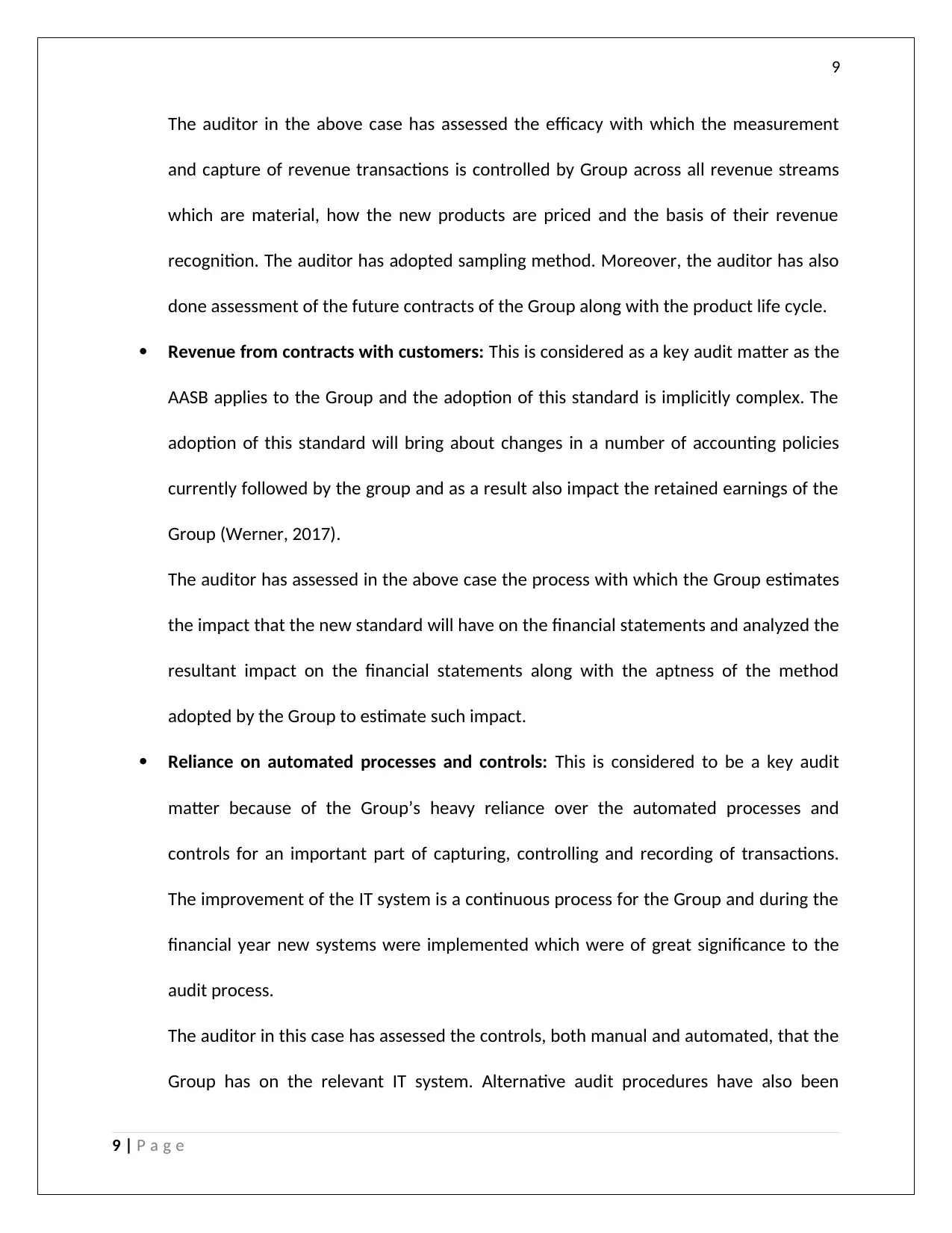
9
The auditor in the above case has assessed the efficacy with which the measurement
and capture of revenue transactions is controlled by Group across all revenue streams
which are material, how the new products are priced and the basis of their revenue
recognition. The auditor has adopted sampling method. Moreover, the auditor has also
done assessment of the future contracts of the Group along with the product life cycle.
Revenue from contracts with customers: This is considered as a key audit matter as the
AASB applies to the Group and the adoption of this standard is implicitly complex. The
adoption of this standard will bring about changes in a number of accounting policies
currently followed by the group and as a result also impact the retained earnings of the
Group (Werner, 2017).
The auditor has assessed in the above case the process with which the Group estimates
the impact that the new standard will have on the financial statements and analyzed the
resultant impact on the financial statements along with the aptness of the method
adopted by the Group to estimate such impact.
Reliance on automated processes and controls: This is considered to be a key audit
matter because of the Group’s heavy reliance over the automated processes and
controls for an important part of capturing, controlling and recording of transactions.
The improvement of the IT system is a continuous process for the Group and during the
financial year new systems were implemented which were of great significance to the
audit process.
The auditor in this case has assessed the controls, both manual and automated, that the
Group has on the relevant IT system. Alternative audit procedures have also been
9 | P a g e
The auditor in the above case has assessed the efficacy with which the measurement
and capture of revenue transactions is controlled by Group across all revenue streams
which are material, how the new products are priced and the basis of their revenue
recognition. The auditor has adopted sampling method. Moreover, the auditor has also
done assessment of the future contracts of the Group along with the product life cycle.
Revenue from contracts with customers: This is considered as a key audit matter as the
AASB applies to the Group and the adoption of this standard is implicitly complex. The
adoption of this standard will bring about changes in a number of accounting policies
currently followed by the group and as a result also impact the retained earnings of the
Group (Werner, 2017).
The auditor has assessed in the above case the process with which the Group estimates
the impact that the new standard will have on the financial statements and analyzed the
resultant impact on the financial statements along with the aptness of the method
adopted by the Group to estimate such impact.
Reliance on automated processes and controls: This is considered to be a key audit
matter because of the Group’s heavy reliance over the automated processes and
controls for an important part of capturing, controlling and recording of transactions.
The improvement of the IT system is a continuous process for the Group and during the
financial year new systems were implemented which were of great significance to the
audit process.
The auditor in this case has assessed the controls, both manual and automated, that the
Group has on the relevant IT system. Alternative audit procedures have also been
9 | P a g e
Paraphrase This Document
Need a fresh take? Get an instant paraphrase of this document with our AI Paraphraser
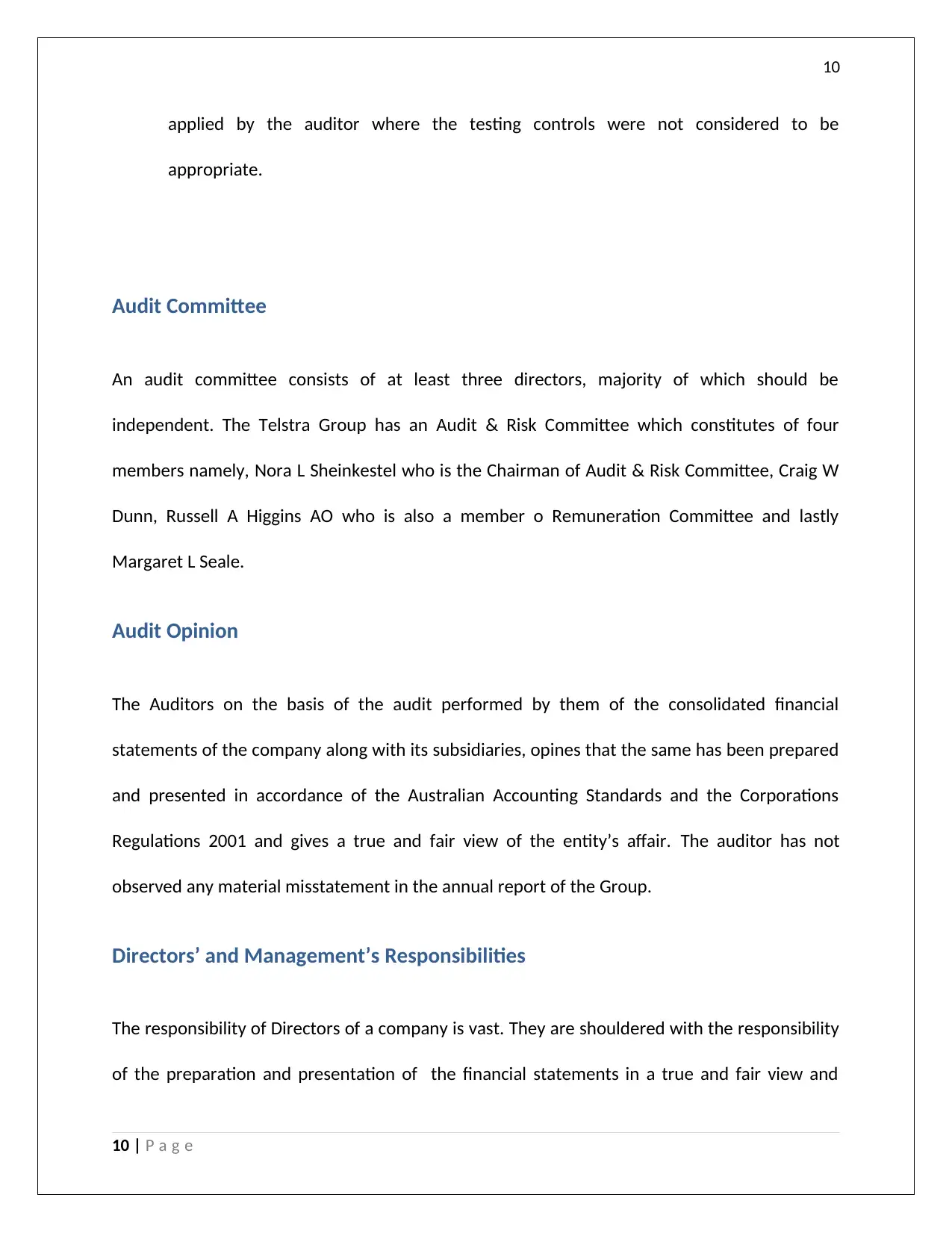
10
applied by the auditor where the testing controls were not considered to be
appropriate.
Audit Committee
An audit committee consists of at least three directors, majority of which should be
independent. The Telstra Group has an Audit & Risk Committee which constitutes of four
members namely, Nora L Sheinkestel who is the Chairman of Audit & Risk Committee, Craig W
Dunn, Russell A Higgins AO who is also a member o Remuneration Committee and lastly
Margaret L Seale.
Audit Opinion
The Auditors on the basis of the audit performed by them of the consolidated financial
statements of the company along with its subsidiaries, opines that the same has been prepared
and presented in accordance of the Australian Accounting Standards and the Corporations
Regulations 2001 and gives a true and fair view of the entity’s affair. The auditor has not
observed any material misstatement in the annual report of the Group.
Directors’ and Management’s Responsibilities
The responsibility of Directors of a company is vast. They are shouldered with the responsibility
of the preparation and presentation of the financial statements in a true and fair view and
10 | P a g e
applied by the auditor where the testing controls were not considered to be
appropriate.
Audit Committee
An audit committee consists of at least three directors, majority of which should be
independent. The Telstra Group has an Audit & Risk Committee which constitutes of four
members namely, Nora L Sheinkestel who is the Chairman of Audit & Risk Committee, Craig W
Dunn, Russell A Higgins AO who is also a member o Remuneration Committee and lastly
Margaret L Seale.
Audit Opinion
The Auditors on the basis of the audit performed by them of the consolidated financial
statements of the company along with its subsidiaries, opines that the same has been prepared
and presented in accordance of the Australian Accounting Standards and the Corporations
Regulations 2001 and gives a true and fair view of the entity’s affair. The auditor has not
observed any material misstatement in the annual report of the Group.
Directors’ and Management’s Responsibilities
The responsibility of Directors of a company is vast. They are shouldered with the responsibility
of the preparation and presentation of the financial statements in a true and fair view and
10 | P a g e
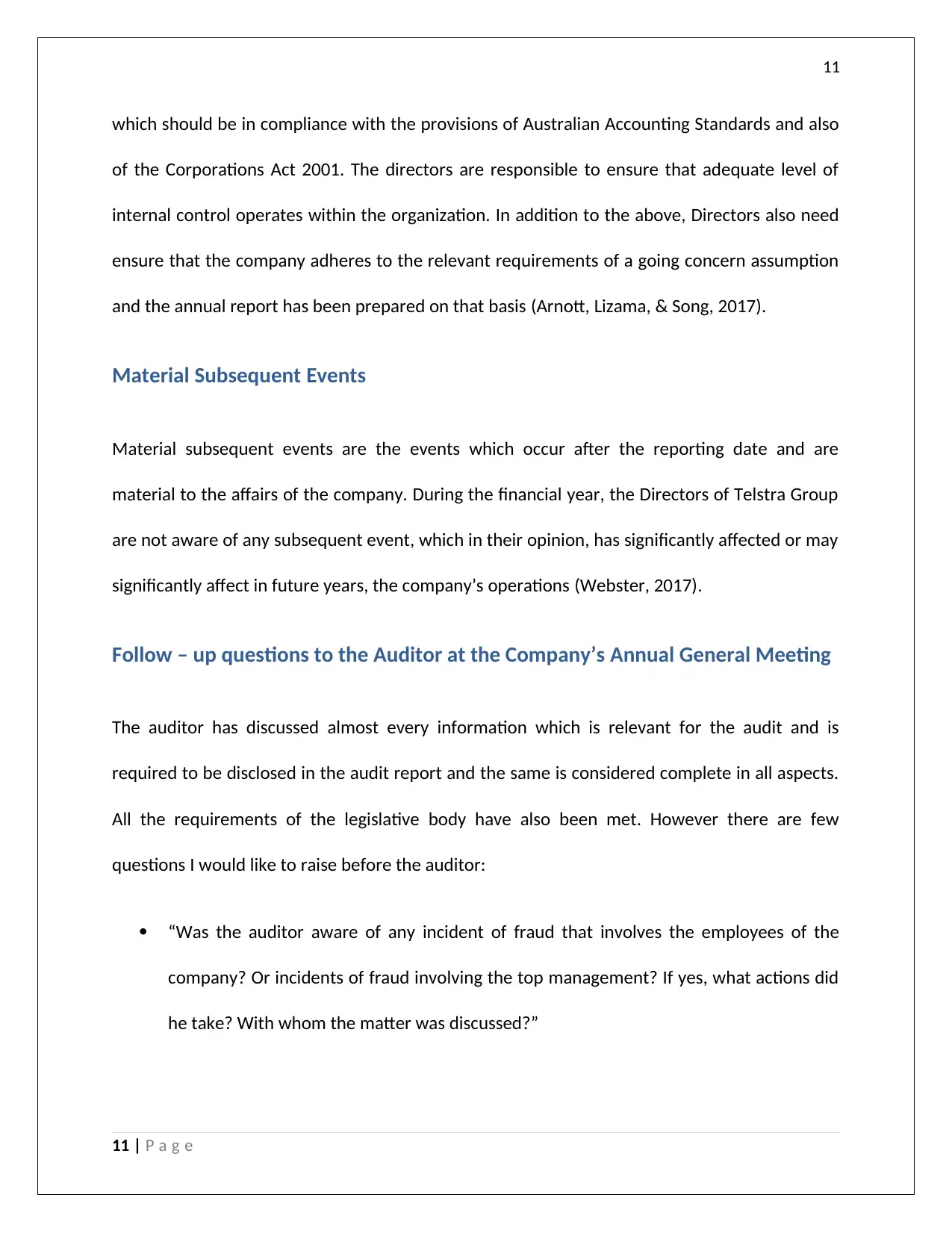
11
which should be in compliance with the provisions of Australian Accounting Standards and also
of the Corporations Act 2001. The directors are responsible to ensure that adequate level of
internal control operates within the organization. In addition to the above, Directors also need
ensure that the company adheres to the relevant requirements of a going concern assumption
and the annual report has been prepared on that basis (Arnott, Lizama, & Song, 2017).
Material Subsequent Events
Material subsequent events are the events which occur after the reporting date and are
material to the affairs of the company. During the financial year, the Directors of Telstra Group
are not aware of any subsequent event, which in their opinion, has significantly affected or may
significantly affect in future years, the company’s operations (Webster, 2017).
Follow – up questions to the Auditor at the Company’s Annual General Meeting
The auditor has discussed almost every information which is relevant for the audit and is
required to be disclosed in the audit report and the same is considered complete in all aspects.
All the requirements of the legislative body have also been met. However there are few
questions I would like to raise before the auditor:
“Was the auditor aware of any incident of fraud that involves the employees of the
company? Or incidents of fraud involving the top management? If yes, what actions did
he take? With whom the matter was discussed?”
11 | P a g e
which should be in compliance with the provisions of Australian Accounting Standards and also
of the Corporations Act 2001. The directors are responsible to ensure that adequate level of
internal control operates within the organization. In addition to the above, Directors also need
ensure that the company adheres to the relevant requirements of a going concern assumption
and the annual report has been prepared on that basis (Arnott, Lizama, & Song, 2017).
Material Subsequent Events
Material subsequent events are the events which occur after the reporting date and are
material to the affairs of the company. During the financial year, the Directors of Telstra Group
are not aware of any subsequent event, which in their opinion, has significantly affected or may
significantly affect in future years, the company’s operations (Webster, 2017).
Follow – up questions to the Auditor at the Company’s Annual General Meeting
The auditor has discussed almost every information which is relevant for the audit and is
required to be disclosed in the audit report and the same is considered complete in all aspects.
All the requirements of the legislative body have also been met. However there are few
questions I would like to raise before the auditor:
“Was the auditor aware of any incident of fraud that involves the employees of the
company? Or incidents of fraud involving the top management? If yes, what actions did
he take? With whom the matter was discussed?”
11 | P a g e
⊘ This is a preview!⊘
Do you want full access?
Subscribe today to unlock all pages.

Trusted by 1+ million students worldwide
1 out of 15
Related Documents
Your All-in-One AI-Powered Toolkit for Academic Success.
+13062052269
info@desklib.com
Available 24*7 on WhatsApp / Email
![[object Object]](/_next/static/media/star-bottom.7253800d.svg)
Unlock your academic potential
Copyright © 2020–2025 A2Z Services. All Rights Reserved. Developed and managed by ZUCOL.





